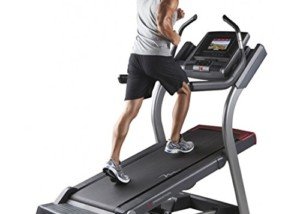
If you’re a treadmill incline devotee, chances are 99 percent you do this wrong, namely, going too fast, and here’s why.
The treadmill incline is perhaps the most incorrectly performed type of exercise because people “walk” way too fast for the selected angle.
I’m a personal trainer and have worked out at many chain gyms in different states; everywhere I’ve ever been, just about every person who uses a treadmill incline goes too fast and clings on, totally negating the intended effect!
How fast should you use a treadmill incline?
I declare with confidence that THE most incorrectly performed exercise involves the treadmill incline: holding onto the machine.
This mistake is angrily defended by those with an assortment of problems such as inner-ear balance issues, dizziness, neuropathy pain, recent knee or back surgery, and other ailments.
It’s not logical to assume that most people who jack up the incline and set the speed to 4 mph, then look like a water skier as they grip the bar, suffer from diabetes neuropathy, vertigo, hip arthritis, herniated disks or inner-ear problems. Many are also young and not overweight.
Many of the people who set the incline to super high and the speed to at least 3 mph are muscled gym rats.
They do superb in other exercises such as the back squat, bench press, chin-up and deadlift.
These are not fragile people. A person who cleanly squats 225 pounds is not likely to have a medical problem that requires them to hold onto a treadmill.
I’ve seen the same people who jack up the incline and speed and hold on for dear life participate in step aerobics and go up staircases without any issues.
So many people commit this error, that it’s illogical to conclude that the vast majority of them have medical problems.
So how fast should the treadmill go at high incline or any incline?
The formula is simple:
Choose a speed that’s similar to what you’d walk up an outdoor hill. How fast to use a treadmill incline mirrors your hiking speed outside.
How fast would you walk up an ongoing hill outdoors? Suppose this hill (assume it’s relatively smooth) is the same angle as the treadmill’s highest incline: 15 percent.
If you normally set the incline at 15 percent and the speed at 4 mph, even 3 mph, ask yourself if you’d be walking this fast up that ongoing outdoor hill.
Suppose that hill goes for miles. Really, would you be maintaining 4 mph, even 3 mph, on that 15 percent grade?
I guarantee it, if you planned on walking that hill for only 10 minutes, you’d naturally set your speed to around 2 mph or less!
What beast maintains a 4 mph walk up a 15 percent trail for 45 minutes?
As an avid hiker and trail runner, I have yet to witness this extraordinary feat. The only people who move this fast up a prolonged grade are trail runners.
How fast should you walk on a treadmill incline?
The same speed you’d move if outdoors on a hike.
You’ll then be able to let go. You don’t hold onto anything while hiking, so why hold onto a treadmill? Because you’ll fall off, right?
No. You won’t fall off if you move at your hiking speed!
Reduce the speed and let go.
This will force your posture to be upright.
If this is too difficult for your legs, don’t hold on. Instead, reduce the speed more.
Pretend you’re hiking outside.
Using a fast speed on a high treadmill incline while holding on subtracts significant workload, burns only a fraction of the calories shown on the console, and can cause repetitive stress injuries in the hips and shoulders.









































